Diving the Yukon
By Dick Long
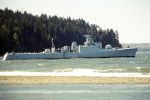 Do you want a great dive? What about a whole series of dives in the same location, with no two alike? Well I have just the opportunity for you. Come let me lead you on a number of dives on the Yukon
Do you want a great dive? What about a whole series of dives in the same location, with no two alike? Well I have just the opportunity for you. Come let me lead you on a number of dives on the Yukon
First a bit of history so you can appreciate how this great opportunity came to be. About 14 years ago, Admiral Box, then the president of the San Diego Oceans Foundation, asked me to look into the possibility of using broken concrete to make man-made reefs off San Diego. I said how difficult can that be? Little did I know? In the process of doing the research for the concrete project, I came across the Artificial Reef Society of British Columbia who was not using concrete but retired Canadian Navy ships. After we completed making an 800-ton reef from broken concrete, the ARSBC called me stating they had an extra 366 foot destroyer escort that they had no home for and would I like to have it? My dive buddy Frank Bird Song said of course we do, Dick, and that started the process. Well it took us 3 1/2 years, about $1.5 million, and about 2500 volunteers to bring the ship from Canada to San Diego, to clean it, and prepare it, and on July 14, 2000 she went to the bottom in 100 feet a water off San Diego, where today without question she is the most exciting dive in Southern California.
One thing I can guarantee you, that no matter whether you are a new diver or a highly experienced technical diver, the Yukon has many adventures waiting for you. Let me describe just a few. This ship has normally Five Marine buoys attached starting with one at the bow, one by the front gun turret, one at the captain’s cabin, one at the single mast and one at the stern. If one is a new diver and a relatively inexperienced around wrecks, a mere simple circumnavigation of the ship will take at least one dive and will be very exciting.
For the first time diver, I recommend a simple orientation dive with an experienced Yukon diver, starting someplace in the center of the ship and swimming forward always staying outside of the ship. When you first come down to the ship you will be impressed by its mere size. It is monstrous. We normally start a new diver coming down at the captain’s cabin and swimming around the flag deck which is directly behind the main mast. As you swim forward of the main mast you will come to the bridge. You can look inside even as you swim around the outside and look in the windows. Then swim forward to the front gun and there is a small door on the right-hand side that you can open and the manual gun control inside still moves. This is where a man would sit in case all the other control systems fail, he could fire the gun himself. (Have your picture taken sitting on the gun barrel.) You then swim forward all the way up to the bow where you drop down onto the sand which is 100 feet and you’ll see the large dolphins that have been cut in the bow on both sides. If anyone tells you they have dove Yukon, ask them what they thought about the dolphins. If they say what dolphins, then you know this person is not a Yukon diver. 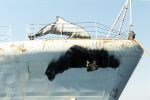 For new divers we will have them swim into the dolphin on the port side across the ship which is only about 15 feet and then out the dolphin on the starboard side with the experienced diver passing through behind them and once on the other side you shake the new divers hand and now they can call themselves a Yukon diver! As a rule we then simply swim back to the line at the captain’s cabin and return to the surface this consuming one tank of air with the appropriate reserve.
For new divers we will have them swim into the dolphin on the port side across the ship which is only about 15 feet and then out the dolphin on the starboard side with the experienced diver passing through behind them and once on the other side you shake the new divers hand and now they can call themselves a Yukon diver! As a rule we then simply swim back to the line at the captain’s cabin and return to the surface this consuming one tank of air with the appropriate reserve.
On succeeding dives you will find, right in the shadow of the mast, two large holes cut in the flag deck which you can look inside. Inside using your flashlight, on the port side you will be looking down on the situation table inside the combat control center. This is the table where they would plot the position of every ship in the formation, any submarines they had detected, a note of any aircraft approaching the ship. If you’re feeling particularly brave you can go into the bridge on the port side, swim across the bridge and out on the starboard side. The windows have all been removed. There is lots of light and there are little or no structures.
On succeeding dives you could explore the rest of the deck areas including the torpedo room, which is just after of the captain’s cabin on the main deck. Behind it see the mortar bay from which they used to fire depth charges and you can drop down over the side and see the turbines, that replace the propellers whenever using the Yukon as a training school for people learning to operate the steam power plant. The turbines are easily visible on the starboard side.
The ship was prepared for divers to be able to enter and exit without having to use any lines to find their way. 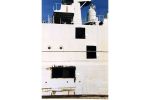 There were holes cut in the side — minimum 4′ x 4′ or larger on every deck throughout the ship. So one is never further than 20 to 40 feet from an entry or exit point and during daylight hours you can always see your way out. One should never go inside the ship until after you have had a wreck diving course and even then you should go with that experienced Yukon diver until you feel fully accustomed to the ship.
There were holes cut in the side — minimum 4′ x 4′ or larger on every deck throughout the ship. So one is never further than 20 to 40 feet from an entry or exit point and during daylight hours you can always see your way out. One should never go inside the ship until after you have had a wreck diving course and even then you should go with that experienced Yukon diver until you feel fully accustomed to the ship.
Among the next dives, when one is totally comfortable and fully trained and properly equipped is usually the first penetration dive entering next to the mast going into the combat control center, swimming passed the situation table where one could see the honor wall. The honor wall contains plaques recognizing the people who donated a great deal of money to the preparation of the ship. Their names are engraved in plastic and proudly displayed on the forward wall of the combat control center. Periodically divers will enter this room and using a scotch pad, brush all of the marine growth from the plaques so you can clearly read the names of the people. I had one made for my family including my grandsons, one of which was only three at the time.
The next dive should not be attempted without an experienced guide with you. This is to enter the engine room. Normally, the experienced diver will go in first, drop down next to the steam turbines, then move back to the gearboxes. The reduction gear boxes where you see these huge gears open for inspection. The experienced diver will stay down on the port gearbox keeping the divers between himself and the opening they came in through. The divers can explore the steam turbines, the control systems, the shafts and then exit the way they came in. 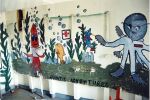 A further even more advanced dive is to go between the propeller shafts into the after magazine. This is where a series of professional murals were painted. And you can still see the murals today after 10 years. On the port side in the back is a picture of a large octopus. The rumor is if the octopus ever turned around and looks at you it’s time to leave.
A further even more advanced dive is to go between the propeller shafts into the after magazine. This is where a series of professional murals were painted. And you can still see the murals today after 10 years. On the port side in the back is a picture of a large octopus. The rumor is if the octopus ever turned around and looks at you it’s time to leave.
One of the more fun dives is to enter the ship, back in the mortar bay where you are at the beginning of Burma Road, which is a passageway that leads all the way from the back of the ship to the bow of the ship. You will pass by one of the artillery generator rooms, pass the mess area where the crew ate, passed the main air induction, passed the chief’s quarters including several toilets. 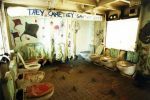 (For some reason divers like to see the toilets.) Then you pass all the way to the bow and come out one of the holes on the side in the front of the ship. That will take one tank of air all by itself.
(For some reason divers like to see the toilets.) Then you pass all the way to the bow and come out one of the holes on the side in the front of the ship. That will take one tank of air all by itself.
There are so many things about the development of the Yukon as a reef it’s difficult to know where to begin describing them. Plumose anemones are common in Northern California waters at diver depths. However in Southern California we normally do not see them until after we pass 130 feet or more. However you will find the Yukon from 70 feet down totally covered with thousands of them. We believe this is because of the unique placement of the ship in a slight current where adequate food is supplied to them You will notice that strawberry anemones or Corynactus are taking over the ship. It takes a long time for these very small anemones to colonize a surface. Because the ship was cut open the way it was and water is allowed to flow through the ship you will find small fishes and their babies all over the ship. We call these Yukon babies. We only wish we could have made the ship into a “no take” zone, but that was not our call. If you love the Yukon which as a diver you will have no choice, then you will discover the possibility of what using ships to make man-made reefs could do for the marine and economic environment. Here is a place where we could go explore and dive in a non-consumptive way. Everybody wins, nobody loses and the ocean is better off for it. If you could come to full appreciation of this that, please consider joining in our efforts to create many, many more dive sites like this up and down the coast ( www.californiashipstoreefs.org ). The next time you’re down there, look for a guy swimming around with flames on his dry suit waving at you, that’s me enjoying the Yukon.
 BlooSee
BlooSee California Ships to Reefs
California Ships to Reefs DUI
DUI eDiving
eDiving Gates Underwater Products
Gates Underwater Products Maritime Museum of San Diego
Maritime Museum of San Diego Ocean Technology Systems
Ocean Technology Systems Scuba Diver Girls
Scuba Diver Girls Waterhorse Charters
Waterhorse Charters Wyland Foundation
Wyland Foundation